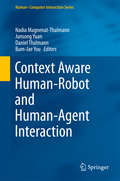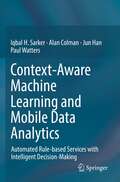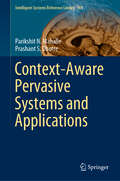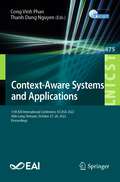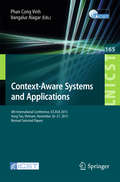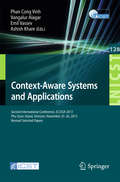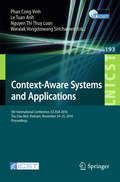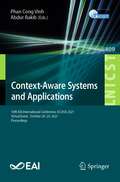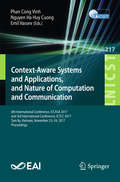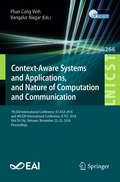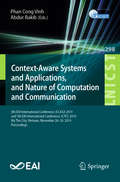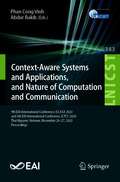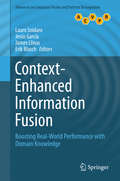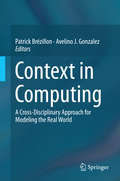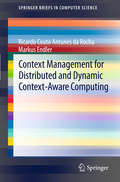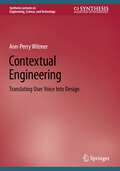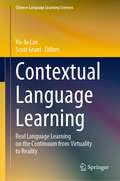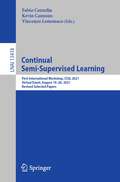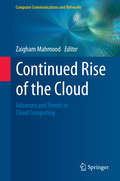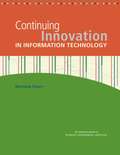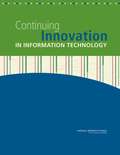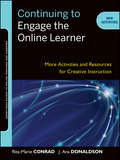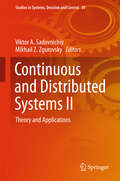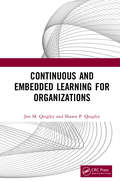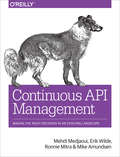- Table View
- List View
Context Aware Human-Robot and Human-Agent Interaction (Human–Computer Interaction Series)
by Daniel Thalmann Nadia Magnenat-Thalmann Junsong Yuan Bum-Jae YouThis is the first book to describe how Autonomous Virtual Humans and Social Robots can interact with real people, be aware of the environment around them, and react to various situations. Researchers from around the world present the main techniques for tracking and analysing humans and their behaviour and contemplate the potential for these virtual humans and robots to replace or stand in for their human counterparts, tackling areas such as awareness and reactions to real world stimuli and using the same modalities as humans do: verbal and body gestures, facial expressions and gaze to aid seamless human- computer interaction (HCI). The research presented in this volume is split into three sections: User Understanding through Multisensory Perception: deals with the analysis and recognition of a given situation or stimuli, addressing issues of facial recognition, body gestures and sound localization. Facial and Body Modelling Animation: presents the methods used in modelling and animating faces and bodies to generate realistic motion. Modelling Human Behaviours: presents the behavioural aspects of virtual humans and social robots when interacting and reacting to real humans and each other. Context Aware Human-Robot and Human-Agent Interaction would be of great use to students, academics and industry specialists in areas like Robotics, HCI, and Computer Graphics.
Context-Aware Machine Learning and Mobile Data Analytics: Automated Rule-based Services with Intelligent Decision-Making
by Paul Watters Jun Han Alan Colman Iqbal SarkerThis book offers a clear understanding of the concept of context-aware machine learning including an automated rule-based framework within the broad area of data science and analytics, particularly, with the aim of data-driven intelligent decision making. Thus, we have bestowed a comprehensive study on this topic that explores multi-dimensional contexts in machine learning modeling, context discretization with time-series modeling, contextual rule discovery and predictive analytics, recent-pattern or rule-based behavior modeling, and their usefulness in various context-aware intelligent applications and services. The presented machine learning-based techniques can be employed in a wide range of real-world application areas ranging from personalized mobile services to security intelligence, highlighted in the book. As the interpretability of a rule-based system is high, the automation in discovering rules from contextual raw data can make this book more impactful for the application developers as well as researchers. Overall, this book provides a good reference for both academia and industry people in the broad area of data science, machine learning, AI-Driven computing, human-centered computing and personalization, behavioral analytics, IoT and mobile applications, and cybersecurity intelligence.
Context-Aware Pervasive Systems and Applications (Intelligent Systems Reference Library #169)
by Parikshit N. Mahalle Prashant S. DhotreThis textbook explores the current challenges in and future prospects of context-aware pervasive systems and applications. The phenomenal advances in broadband technology and ubiquitous access to the Internet have transformed Internet computing into the Internet of Things (IoT), which is now evolving toward the Internet of Everything. Modern scientific, engineering, and business applications are increasingly dependent on machine-to-machine communication, wherein there is less human intervention. In turn, this creates a need for context-aware pervasive systems and applications in which RFID, sensors, and smartphones play a key role. The book provides an essential overview of context, context management, and how to perform context management in various use cases. In addition, it addresses context-aware computing and personalization, various architectures for context-aware systems, and security issues. The content is explained using straightforward language and easy-to-follow examples, case studies, technical descriptions, procedures, algorithms, and protocols for context-aware systems.
Context-Aware Systems and Applications: 11th EAI International Conference, ICCASA 2022, Vinh Long, Vietnam, October 27-28, 2022, Proceedings (Lecture Notes of the Institute for Computer Sciences, Social Informatics and Telecommunications Engineering #475)
by Cong Vinh Phan Thanh Dung NguyenThis book constitutes the 11th EAI International Conference of the International Conference on Context-Aware Systems and Applications, ICCASA 2022, held in Vinh Long, Vietnam, during October 27-28, 2022. The 14 revised full papers presented were carefully selected from 40 submissions. The papers cover a wide spectrum of modern approaches and techniques for smart computing systems and their applications.
Context-Aware Systems and Applications: 4th International Conference, ICCASA 2015, Vung Tau, Vietnam, November 26-27, 2015, Revised Selected Papers (Lecture Notes of the Institute for Computer Sciences, Social Informatics and Telecommunications Engineering #165)
by Phan Cong Vinh Vangalur AlagarThis book constitutesthe thoroughly refereed proceedings of the 4th International Conference onContext-Aware Systems and Applications, ICCASA 2015, held in Vung Tau, Vietnam,in November 2015. The 44 revised full papers presented were carefully selectedand reviewed from over 100 submissions. The papers cover a wide spectrum ofissues in the area of context-aware systems (CAS) and context-basedrecommendation systems. CAS is characterized by its self- facets such as self-organization, self-configuration,self-healing, self-optimization, self-protection and so on whose context awarenessused to dynamically control computing and networking functions. The overallgoal of CAS is to realize nature-inspired autonomic systems that can manage themselveswithout direct human interventions.
Context-Aware Systems and Applications: Second International Conference, ICCASA 2013, Phu Quoc Island, Vietnam, November 25-26, 2013, Revised Selected Papers (Lecture Notes of the Institute for Computer Sciences, Social Informatics and Telecommunications Engineering #128)
by Phan Cong Vinh Vangalur Alagar Emil Vassev Ashish KhareThis book constitutes the thoroughly refereed proceedings of the Second International Conference on Context-Aware Systems and Applications, ICCASA 2013, held in Phu Quoc Island, Vietnam in November 2013. The 36 revised full papers presented were carefully selected and reviewed from over 100 submissions and cover a wide spectrum of issues in the area of context-aware systems (CAS) and context-based recommendation systems.
Context-Aware Systems and Applications: 5th International Conference, ICCASA 2016, Thu Dau Mot, Vietnam, November 24-25, 2016, Proceedings (Lecture Notes of the Institute for Computer Sciences, Social Informatics and Telecommunications Engineering #193)
by Phan Cong Vinh Le Tuan Anh Nguyen Thi Thuy Loan Waralak Vongdoiwang SiricharoenThis book constitutesthe thoroughly refereed proceedings of the 4th International Conference onContext-Aware Systems and Applications, ICCASA 2015, held in Vung Tau, Vietnam,in November 2015. The 44 revised full papers presented were carefully selectedand reviewed from over 100 submissions. The papers cover a wide spectrum ofissues in the area of context-aware systems (CAS) and context-basedrecommendation systems. CAS is characterized by its self- facets such as self-organization, self-configuration,self-healing, self-optimization, self-protection and so on whose context awarenessused to dynamically control computing and networking functions. The overallgoal of CAS is to realize nature-inspired autonomic systems that can manage themselveswithout direct human interventions.
Context-Aware Systems and Applications: 10th EAI International Conference, ICCASA 2021, Virtual Event, October 28–29, 2021, Proceedings (Lecture Notes of the Institute for Computer Sciences, Social Informatics and Telecommunications Engineering #409)
by Phan Cong Vinh Abdur RakibThis book constitutes the refereed post-conference proceedings of the International Conference on Context-Aware Systems and Applications, held in October 2021. Due to COVID-19 pandemic the conference was held virtually. The 25 revised full papers presented were carefully selected from 52 submissions. The papers cover a wide spectrum of modern approaches and techniques for smart computing systems and their applications.
Context-Aware Systems and Applications, and Nature of Computation and Communication: 6th International Conference, Iccasa 2017, And 3rd International Conference, Ictcc 2017, Tam Ky, Vietnam, November 23-24, 2017, Proceedings (Lecture Notes of the Institute for Computer Sciences, Social Informatics and Telecommunications Engineering #217)
by Emil Vassev Nguyen Ha Huy Cuong Phan Cong VinhThis book constitutes the refereed post-conference proceedings of the International Conferences ICCASA and ICTCC 2017, held in November 2017 in Tam Ky City, Vietnam. The 23 revised full papers presented were carefully selected from 31 submissions. The papers of ICCASA cover a wide spectrum in the area of context-aware-systems. CAS is characterized by its self- facets such as self-organization, self-configuration, self-healing, self-optimization, self-protection used to dynamically control computing and networking functions. The papers of ICTCC cover formal methods for self-adaptive systems and discuss natural approaches and techniques for computation and communication.
Context-Aware Systems and Applications, and Nature of Computation and Communication: 7th EAI International Conference, ICCASA 2018, and 4th EAI International Conference, ICTCC 2018, Viet Tri City, Vietnam, November 22–23, 2018, Proceedings (Lecture Notes of the Institute for Computer Sciences, Social Informatics and Telecommunications Engineering #266)
by Phan Cong Vinh Vangalur AlagarThis book constitutes the refereed post-conference proceedings of the International Conferences ICCASA and ICTCC 2018, held in November 2018 in Viet Tri City, Vietnam. The 20 revised full papers presented were carefully selected from 30 submissions. The papers of ICCASA cover a wide spectrum in the area of context-aware-systems. CAS is characterized by its self- facets such as self-organization, self-configuration, self-healing, self-optimization, self-protection used to dynamically control computing and networking functions. The papers of ICTCC cover formal methods for self-adaptive systems and discuss natural approaches and techniques for computation and communication.
Context-Aware Systems and Applications, and Nature of Computation and Communication: 8th EAI International Conference, ICCASA 2019, and 5th EAI International Conference, ICTCC 2019, My Tho City, Vietnam, November 28-29, 2019, Proceedings (Lecture Notes of the Institute for Computer Sciences, Social Informatics and Telecommunications Engineering #298)
by Phan Cong Vinh Abdur RakibThis book constitutes the refereed post-conference proceedings of the International Conferences ICCASA and ICTCC 2019, held in November 2019 in My Tho, Vietnam. The 20 revised full papers presented were carefully selected from 33 submissions. The papers of ICCASA cover a wide spectrum in the area of context-aware-systems. CAS is characterized by its self- facets such as self-organization, self-configuration, self-healing, self-optimization, self-protection used to dynamically control computing and networking functions. The papers of ICTCC cover formal methods for self-adaptive systems and discuss natural approaches and techniques for computation and communication.
Context-Aware Systems and Applications, and Nature of Computation and Communication: 9th EAI International Conference, ICCASA 2020, and 6th EAI International Conference, ICTCC 2020, Thai Nguyen, Vietnam, November 26–27, 2020, Proceedings (Lecture Notes of the Institute for Computer Sciences, Social Informatics and Telecommunications Engineering #343)
by Phan Cong Vinh Abdur RakibThis book constitutes the refereed post-conference proceedings of the International Conferences ICCASA and ICTCC 2020, held in November 2020 in Thai Nguyen, Vietnam. The 27 revised full papers presented were carefully selected from 68 submissions. The papers of ICCASA cover a wide spectrum in the area of context-aware-systems. CAS is characterized by its self- facets such as self-organization, self-configuration, self-healing, self-optimization, self-protection used to dynamically control computing and networking functions. The papers of ICTCC cover formal methods for self-adaptive systems and discuss natural approaches and techniques for computation and communication.
Context-Enhanced Information Fusion: Boosting Real-World Performance with Domain Knowledge (Advances in Computer Vision and Pattern Recognition #0)
by Jesús García Lauro Snidaro James Llinas Erik BlaschThis text reviews the fundamental theory and latest methods for including contextual information in fusion process design and implementation. Chapters are contributed by the foremost international experts, spanning numerous developments and applications. The book highlights high- and low-level information fusion problems, performance evaluation under highly demanding conditions, and design principles. A particular focus is placed on approaches that integrate research from different communities, emphasizing the benefit of combining different techniques to overcome the limitations of a single perspective. Features: introduces the terminology and core elements in information fusion and context; presents key themes for context-enhanced information fusion; discusses design issues in developing context-aware fusion systems; provides mathematical grounds for modeling the contextual influences in representative fusion problems; describes the fusion of hard and soft data; reviews a diverse range of applications.
Context in Computing: A Cross-Disciplinary Approach for Modeling the Real World
by Patrick Brézillon Avelino J. GonzalezThis volume explores how context has been and can be used in computing to model human behaviors, actions and communications as well as to manage data and knowledge. It addresses context management and exploitation of context for sharing experience across domains. The book serves as a user-centric guide for readers wishing to develop context-based applications, as well as an intellectual reference on the concept of context. It provides a broad yet deep treatment of context in computing and related areas that depend heavily on computing. The coverage is broad because of its cross-disciplinary nature but treats topics at a sufficient depth to permit a reader to implement context in his/her computational endeavors. The volume addresses how context can be integrated in software and systems and how it can be used in a computing environment. Furthermore, the use of context to represent the human dimension, individually as well as collectively is explained. Contributions also include descriptions of how context has been represented in formal as well as non-formal, structured approaches. The last section describes several human behavior representation paradigms based on the concept of context as its central representational element. The depth and breadth of this content is certain to provide useful as well as intellectually enriching information to readers of diverse backgrounds who have an interest in or are intrigued by using context to assist in their representation of the real world.
Context Management for Distributed and Dynamic Context-Aware Computing (SpringerBriefs in Computer Science)
by Markus Endler Ricardo Couto RochaResearch in context-aware computing has produced a number of middleware systems for context management. However, development of ubiquitous context-aware applications is still a challenge because most current middleware systems are still focused on isolated and static context-aware environments. Context-aware environments are inherently dynamic as a result of occasional additions or upgrade of sensors, applications or context inference mechanisms. Context Management for Distributed and Dynamic Context-Aware Computing proposes a novel architecture for context management based on the concept of context domains, allowing applications to keep context interests across distributed context management systems. The authors describe a distributed middleware that implements the aforementioned concepts, without compromising scalability and efficiency of context access.
Contextual Engineering: Translating User Voice Into Design (Synthesis Lectures on Engineering, Science, and Technology)
by Ann-Perry WitmerThis book shows readers a new way of thinking about the engineering design process, as well as how to expand their understanding of the role of technical designers in society, whether working with international communities or user populations from their own hometown. As readers build an understanding of Contextual Engineering, this book will challenge them to think about the applicability of the concept more broadly, not only in terms of technical design but in personal and professional interactions with others as well. At the same time, readers will learn techniques to explore their own predispositions and the biases they may not be aware they have, equipping them to interact with others more impartially. This self-reflection process also assists the designer in working with and accepting the uncertainty that is inherent in exploring context.
Contextual Language Learning: Real Language Learning on the Continuum from Virtuality to Reality (Chinese Language Learning Sciences)
by Yu-Ju Lan Scott GrantThis book presents research and developments in the virtual, augmented technology and mixed-reality used in language learning and teaching. It provides the readers with a comprehensive overview of contextual language learning with the support of immersive technology. From theoretical foundations, methodological issues, the features of virtual and augmented reality, and educational practices of language learning, to the future of immersive technology for and research on language learning. During the past two decades, abundant research on different realities has recognized the potential of language learning in virtual, augmented, and mixed-reality environments (Wang et al., 2020; Lin & Lan, 2015). Given insufficient studies of Chinese learning in immersive contexts reported in existing literature, this book includes several excellent studies about using immersive technologies for Chinese learning in addition to other foreign langue learning, such as English as a foreign language (EFL). Since learning Chinese has grown significantly as a global trend, the authors vitally consolidate and synthesize various theoretical foundations, visions, and recent research and practices in the context of Chinese teaching from broader and more diverse perspectives. On the other hand, the chapters about EFL learning also shed light on the research on contextual language learning. Thus, the chapters included in this book will likely provide readers with a deep and extensive understanding of the potential of the smart combination of immersive technologies and language learning. More issues for future research will undoubtedly be inspired by reading the chapters in this book.
Continual Semi-Supervised Learning: First International Workshop, CSSL 2021, Virtual Event, August 19–20, 2021, Revised Selected Papers (Lecture Notes in Computer Science #13418)
by Fabio Cuzzolin Kevin Cannons Vincenzo LomonacoThis book constitutes the proceedings of the First International Workshop on Continual Semi-Supervised Learning, CSSL 2021, which took place as a virtual event during August 2021.The 9 full papers and 0 short papers included in this book were carefully reviewed and selected from 14 submissions.
Continued Rise of the Cloud: Advances and Trends in Cloud Computing (Computer Communications and Networks)
by Zaigham MahmoodThis book captures the state of the art in cloud technologies, infrastructures, and service delivery and deployment models. The work provides guidance and case studies on the development of cloud-based services and infrastructures from an international selection of expert researchers and practitioners. Features: presents a focus on security and access control mechanisms for cloud environments, analyses standards and brokerage services, and investigates the role of certification for cloud adoption; evaluates cloud ERP, suggests a framework for implementing "big data" science, and proposes an approach for cloud interoperability; reviews existing elasticity management solutions, discusses the relationship between cloud management and governance, and describes the development of a cloud service capability assessment model; examines cloud applications in higher education, including the use of knowledge-as-a-service in the provision of education, and cloud-based e-learning for students with disabilities.
Continuing Innovation in Information Technology: Workshop Report
by Engineering Medicine National Academies of SciencesThe 2012 National Research Council report Continuing Innovation in Information Technology illustrates how fundamental research in information technology (IT), conducted at industry and universities, has led to the introduction of entirely new product categories that ultimately became billion-dollar industries. The central graphic from that report portrays and connects areas of major investment in basic research, university-based research, and industry research and development; the introduction of important commercial products resulting from this research; billion-dollar-plus industries stemming from it; and present-day IT market segments and representative U.S. firms whose creation was stimulated by the decades-long research. At a workshop hosted by the Computer Science and Telecommunications Board on March 5, 2015, leading academic and industry researchers and industrial technologists described key research and development results and their contributions and connections to new IT products and industries, and illustrated these developments as overlays to the 2012 "tire tracks" graphic. The principal goal of the workshop was to collect and make available to policy makers and members of the IT community first-person narratives that illustrate the link between government investments in academic and industry research to the ultimate creation of new IT industries. This report provides summaries of the workshop presentations organized into five broad themes - (1) fueling the innovation pipeline, (2) building a connected world, (3) advancing the hardware foundation, (4) developing smart machines, and (5) people and computers - and ends with a summary of remarks from the concluding panel discussion.
Continuing Innovation in Information Technology
by National Research Council Committee on Depicting Innovation in Information Technology Division on Engineering and Physical Sciences Computer Science and Telecommunications BoardInformation technology (IT) is widely understood to be the enabling technology of the 21st century. IT has transformed, and continues to transform, all aspects of our lives: commerce and finance, education, employment, energy, health care, manufacturing, government, national security, transportation, communications, entertainment, science, and engineering. IT and its impact on the U.S. economy-both directly (the IT sector itself) and indirectly (other sectors that are powered by advances in IT)--continue to grow in size and importance. In 1995, the National Research Council's Computer Science and Telecommunications Board (CSTB) produced the report Evolving the High Performance Computing and Communications Initiative to Support the Nation's Information Infrastructure. A graphic in that report, often called the "tire tracks" diagram because of its appearance, produced an extraordinary response by clearly linking government investments in academic and industry research to the ultimate creation of new information technology industries with more than $1 billion in annual revenue. Used in presentations to Congress and executive branch decision makers and discussed broadly in the research and innovation policy communities, the tire tracks figure dispelled the assumption that the commercially successful IT industry is self-sufficient, underscoring through long incubation periods of years and even decades. The figure was updated in 2002, 2003, and 2009 reports produced by the CSTB. With the support of the National Science Foundation, CSTB updated the tire tracks figure. Continuing Innovation in Information Technology includes the updated figure and a brief text based in large part on prior CSTB reports.
Continuing to Engage the Online Learner
by Rita-Marie Conrad J. Ana DonaldsonThis book includes a definitive model for engaged learning that can be applied in a wide range of on-line learning environments and across age levels. It also addresses current topics such as engaging in a blended learning environment, social networking, and using related technology tools. Continuing to Engage the Online Learner provides an introduction to the theory of engaged learning and its design, assessment, and management in online and blended learning environments. In addition, the book describes the types of activities that engage the online learner in each phase of engagement and provides 50 new examples of activities.
Continuous and Distributed Systems II: Theory and Applications (Studies in Systems, Decision and Control #30)
by Mikhail Z. Zgurovsky Viktor A. SadovnichiyAs in the previous volume on the topic, the authors close the gap between abstract mathematical approaches, such as applied methods of modern algebra and analysis, fundamental and computational mechanics, nonautonomous and stochastic dynamical systems, on the one hand, and practical applications in nonlinear mechanics, optimization, decision making theory and control theory on the other. Readers will also benefit from the presentation of modern mathematical modeling methods for the numerical solution of complicated engineering problems in biochemistry, geophysics, biology and climatology. This compilation will be of interest to mathematicians and engineers working at the interface of these field. It presents selected works of the joint seminar series of Lomonosov Moscow State University and the Institute for Applied System Analysis at National Technical University of Ukraine "Kyiv Polytechnic Institute". The authors come from Brazil, Germany, France, Mexico, Spain, Poland, Russia, Ukraine, and the USA.
Continuous and Embedded Learning for Organizations
by Jon M. Quigley Shawn P. QuigleyThere is considerable connection between growth of the personnel in the organization and the ability for the company to compete over time. Looking outside for help training may be required but looking within for opportunities for enhanced training and growth, will foster a continually improving and growing organization. This book examines the opportunities for learning, within the organization and its’ activities, along with the connection to motivation. Additionally, it provides information on the characteristics of organizations that are able to quickly disseminate, along with approaches for improving this distribution of that learning throughout the organization.
Continuous API Management: Making the Right Decisions in an Evolving Landscape
by Mehdi Medjaoui Erik Wilde Ronnie Mitra Mike AmundsenA lot of work is required to release an API, but the effort doesn’t always pay off. Overplanning before an API matures is a wasted investment, while underplanning can lead to disaster. This practical guide provides maturity models for individual APIs and multi-API landscapes to help you invest the right human and company resources for the right maturity level at the right time.How do you balance the desire for agility and speed with the need for robust and scalable operations? Four experts from the API Academy show software architects, program directors, and product owners how to maximize the value of their APIs by managing them as products through a continuous life cycle.Learn which API decisions you need to govern and how and where to do soDesign, deploy, and manage APIs using an API-as-a-product (AaaP) approachExamine ten pillars that form the foundation of API product workLearn how the continuous improvement model governs changes throughout an API’s lifetimeExplore the five stages of a complete API product life cycleDelve into team roles needed to design, build, and maintain your APIsLearn how to manage your API landscape—the set of APIs published by your organization
